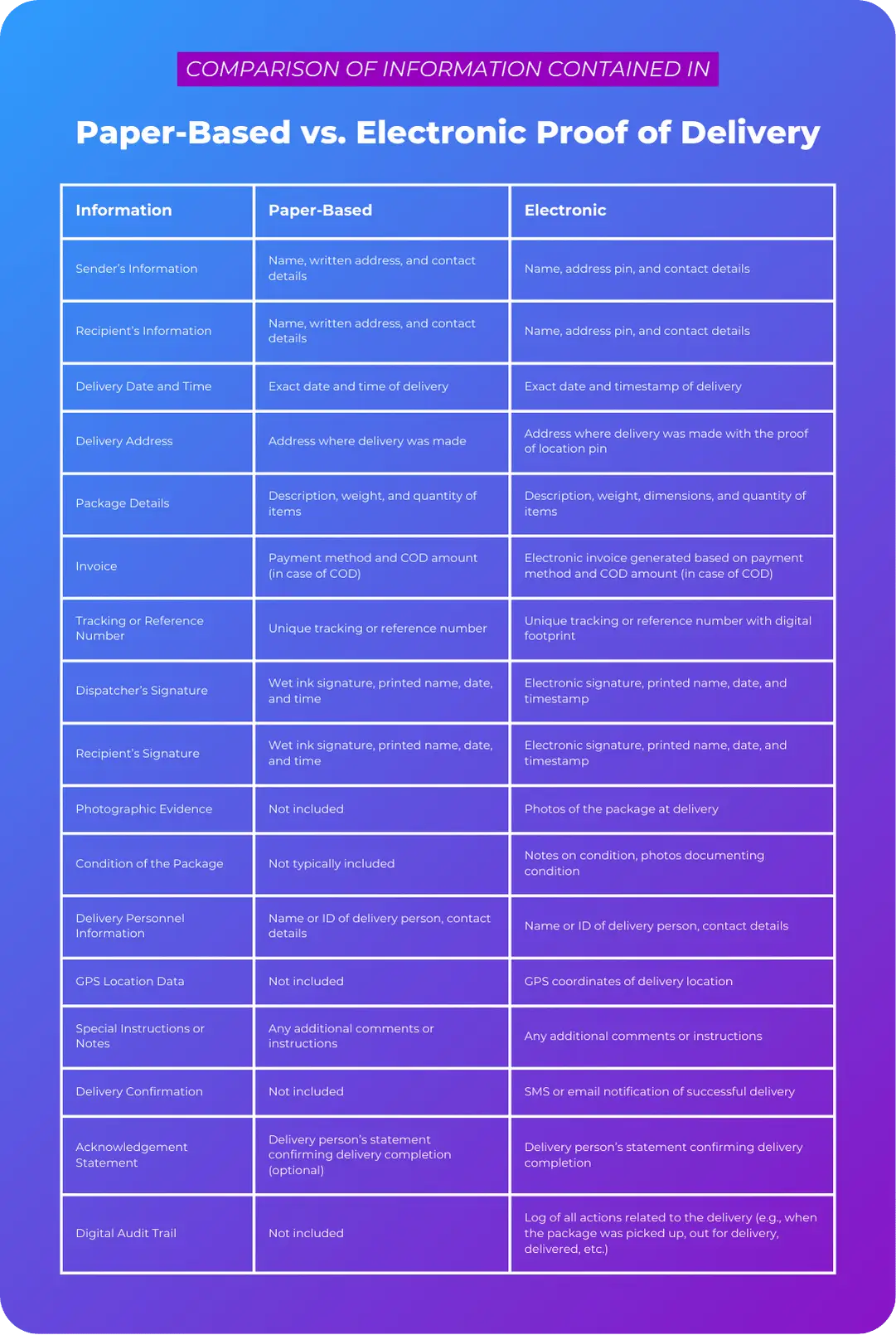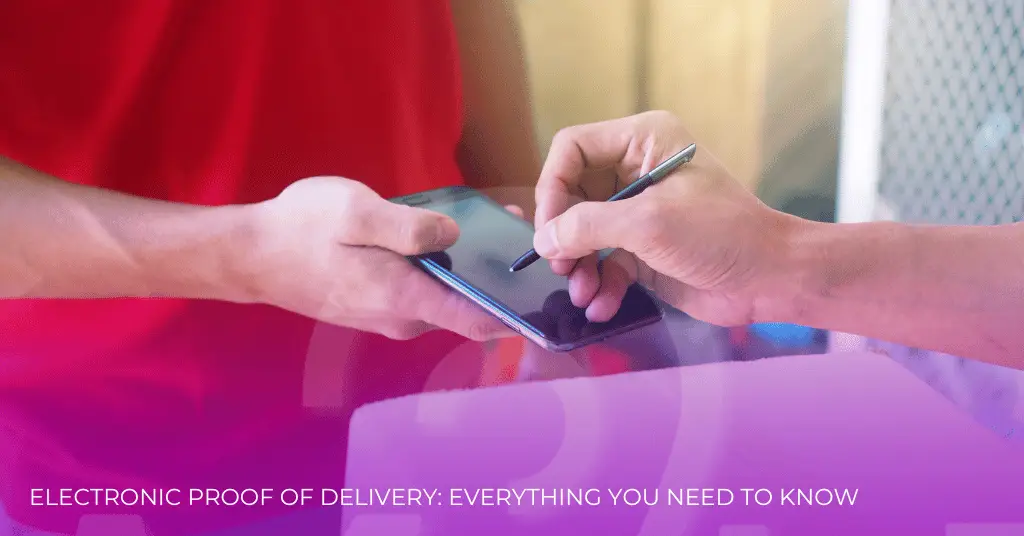إثبات التسليم الإلكتروني هو وثيقة رقمية تثبت إتمام عملية التسليم بنجاح. تابع القراءة لمعرفة كيفية عملها.
حسنًا، في عالم مثالي، قد ترغب في أن تعمل عمليات التسليم الخاصة بك تلقائيًا دون الحاجة إلى تتبع حالتها دقيقة بدقيقة. ولكن للأسف، هذا ليس هو الحال، وقد تجد نفسك تكافح لإرضاء العملاء الذين يزعمون أن طردهم لم يتم تسليمه أبدًا، أو أنه وصل تالفًا، أو أن موظف التوصيل تركه في المكان الخطأ.
وإذا لم يكن لديك دليل يثبت أن الطرد تم تسليمه في الموقع المحدد وفي حالة جيدة، فإن الأمر لا يعدو أن يكون مجرد كلام العميل ضد كلامك. ولإنقاذ الموقف، قد تفكر أيضًا في تقديم استرداد للمبلغ الذي دفعه العميل بالإضافة إلى ترتيب إعادة تسليم الطرد "المفقود".
لكن مهلا، لدينا أخبار جيدة لك: يمكن لإثبات التسليم أن يحميك من نزاعات العملاء والخسائر المالية التي يتعين عليك تحملها رغماً عنك بسبب الطلبات التي تبدو غير مكتملة.
كما يوحي الاسم، فإن إثبات التسليم هو تأكيد يثبت تسليم الطرد في الحالة الصحيحة للشخص المناسب في الموقع الصحيح.
أنواع إثبات التسليم
يمكن أن يكون دليل التسليم رقميًا وورقيًا.
ورقي
عادةً ما يكون ذلك في شكل مستند مادي أو إيصال ويتطلب توقيعات تقليدية بالحبر الرطب للتحقق من صحتها في كل خطوة من خطوات دورة التسليم. على سبيل المثال، عند إرسال طلب، يوقع المرسل على إثبات التسليم، ويوقعه المستلم عند الاستلام.
تتطلب أدلة التسليم الورقية الكثير من التدخل البشري، وهي عرضة للتلف أو الضياع، وقد تؤدي إلى أخطاء في إدخال البيانات. ولكن على الرغم من عيوبها العديدة، لا تزال المستندات الورقية تحظى باستخدام واسع النطاق اليوم. ولا ننسى أن الاستخدام غير المحدود للورق يشكل خطرًا على البيئة أيضًا.
إثبات التسليم الإلكتروني
يتضمن ذلك استخدام التكنولوجيا الرقمية مثل رمز الاستجابة السريعة (QR) والصور والتوقيعات الإلكترونية لتمييز التسليم بأنه مكتمل. أفضل برامج إدارة التسليم تقدم الآن أدلة إلكترونية متعددة للتسليم، لأنها أكثر دقة وأمانًا وصديقة للبيئة.

هل يختلف إثبات التسليم عن بوليصة الشحن؟
إثبات التسليم و بوليصة الشحن هما وثيقتان أساسيتان في مجال الخدمات اللوجستية، لكنهما تخدمان غرضين مختلفين.
تُستخدم وثيقة الشحن في المراحل المبكرة من سلسلة التوريد لصياغة الاتفاقيات بين الشاحنين وشركات النقل. وهي أكثر تفصيلاً من وثيقة إثبات التسليم النموذجية وتوفر معلومات إضافية، بما في ذلك وصف البضائع التي يتم نقلها ورقم أمر الشراء.
كما أن سند الشحن، على عكس إثبات التسليم، هو عقد ملزم قانونًا لأنه يحدد شروط وأحكام الشحنة. كما يعمل كإيصال شحن ويوقع عليه ممثل مفوض لشركة الشحن عندما يسلم الناقل الشحنة إلى مستودع أو مركز تنفيذ. على النقيض من ذلك، يتم استخدام إثبات التسليم بشكل شائع في التسليم في الميل الأخيرحيث يتم تسليم الطرد إلى العميل.
ببساطة، يعتبر إثبات التسليم ووثيقة الشحن على نفس القدر من الأهمية لأنهما يساعدان في تتبع الشحنات والطرود وحماية المسؤولية. ومع ذلك، فإنهما ليسا متطابقين، وبالتالي لا يمكن استخدامهما بالتبادل.
الفوائد الرئيسية لإثبات التسليم الإلكتروني
لم تعد الطرود مفقودة بعد الآن
تُعَد الطرود المفقودة أو المسروقة من نقاط الألم الرئيسية لعمليات التوصيل. وغالبًا ما تؤدي المستندات الورقية إلى مسارات ورقية طويلة تجعل تخزين واسترجاع إثبات التسليم الورقي أمرًا مرهقًا وأقل كفاءة. كما تستخدم كميات كبيرة من الورق، مما يكلف الشركات الكثير من المال.
يوفر لك إثبات التسليم الإلكتروني الكثير من هذه المتاعب. إن الجمع بين سهولة الاستخدام وقوالب إثبات التسليم القابلة للتخصيص وتحميل الصور والتقاط التوقيع الإلكتروني المدمج يعمل على تبسيط عملية إنشاء إثبات التسليم والتوقيع عليه. ميل وتتضمن أنظمة إدارة التسليم الأخرى أداة لتحويل التوقيعات المكتوبة بخط اليد من jpg أو jpeg إلى png، مما يحول الصورة إلى توقيع إلكتروني شفاف، جاهز للتحميل على مستند إثبات التسليم الرقمي.
عندما تكون الصورة أو التوقيع الإلكتروني مطلوبين للتحقق من صحة التسليم، تقل احتمالية تعرض الطرود للتلف أو السرقة أو العناوين غير الصحيحة أو التوقيعات غير الصحيحة.
لم تعد عمليات التسليم الجزئية أو الخاطئة مصدر إزعاج
هناك سبب آخر يجعل إثبات التسليم الإلكتروني يحل محل نظيره الورقي وهو أنه يحل مشكلة الطلبات التي تم تسليمها جزئيًا أو بشكل غير صحيح بسلاسة. قد يستغرق الأمر ساعات أو أيامًا لنقل المعلومات فعليًا حول الطرود التي تم تسليمها مع وجود بعض العناصر الخاطئة أو المفقودة. في أفضل السيناريوهات، يمكنك إرسال مندوب لتقديم إثبات التسليم الورقي إلى المرسل في مركز التنفيذ في نفس اليوم. ولكن مع إثبات التسليم الإلكتروني، يصل إليهم على الفور تقريبًا عبر تطبيق إدارة التوصيل، والتي يستخدمونها للتحقق من حالة التسليم لكل طلب يرسلونه في يوم معين.
العملاء واثقون من خدماتك
وكما هي الحال، فإن تأخر التسليم يؤدي إلى استياء العملاء. ويشعر العملاء بغضب أكبر عندما تكون الحزمة التي يتلقونها خاطئة أو غير كاملة أو تالفة. وعلى عكس التوقيعات المادية، التي تكون عرضة للتزوير، فإن التوقيعات الإلكترونية من المستحيل التلاعب بها. وعلاوة على ذلك، يتضمن إثبات التسليم الإلكتروني مسارات تدقيق مفصلة لوقت استلام الحزمة، ومكان تسليمها، ومن استلمها. كما يسجل ويختم تاريخ أي تغييرات أو تعديلات أجريت على عملية التسليم قبل تسليم الحزمة.
كما يعمل خيار تحميل الصور غير المحدود على الحد من أي فرصة للسلوك الاحتيالي. على سبيل المثال، يمكن لسائق التوصيل التقاط صورة للعناصر التي تم تسليمها والمكان الدقيق الذي تركها فيه. وبفضل ميزة ختم الوقت والتحميل التلقائية في التطبيق، تكون تفاصيل طلب العميل متاحة بسهولة في مكان واحد مناسب. وحتى إذا لم يكن العميل موجودًا لاستلام الطلب شخصيًا، فيمكنه الاطمئنان إلى أن طروده وصلت بأمان عندما يرى دليلًا مصورًا على التسليم.
إن هذا البناء المتزايد للدقة والشفافية ثقة العملاء بالإضافة إلى ذلك، نظرًا لتفضيل العملاء المتزايد للتسليم بدون تلامس، فإن إثبات التسليم الإلكتروني، سواء من خلال الصور أو التوقيعات الإلكترونية أو كليهما، يوفر مستوى من راحة البال لا يمكن للإيصالات الورقية توفيره أبدًا.
تستطيع شركات التوصيل أيضًا التعامل مع عمليات رد الأموال والإرجاع الناتجة عن عمليات التسليم المتأخرة أو التالفة أو غير الصحيحة بكفاءة أكبر باستخدام نظام إثبات التسليم الإلكتروني. وبالمقارنة بالإيصالات الورقية، التي يمكن التلاعب بها والتلاعب بها بسهولة إلى حد ما، فإن إثبات التسليم الإلكتروني يمنحك الدليل الكامل والدقيق الذي تحتاجه للتحقق من طلبات رد الأموال.
كيف يعمل إثبات التسليم الإلكتروني؟
تتكون ميزة إثبات التسليم الإلكتروني القياسية عادةً من جزأين:
- تطبيق سائق يسمح للمستخدمين بالوصول إلى البيانات المتعلقة بالتسليم وجمعها أثناء التنقل
- لوحة معلومات مركزية تمكن المكتب الخلفي من مراقبة العمليات الميدانية
يستخدم سائقو التوصيل هواتفهم وأجهزتهم اللوحية التي تعمل بنظام التشغيل iOS أو Android لتسجيل عمليات التوصيل وجمع البيانات التشغيلية الأخرى حسب الحاجة. ويستقبل المحور المركزي ويخزن جميع البيانات الميدانية المجمعة، بما في ذلك بيانات جهاز العميل وموقعه، للتحليلات التنبؤية.
يمكن للفرق في المكتب عرض الظروف الميدانية في الوقت الحقيقي، ومراقبة سلوك السائق أثناء رحلاته، وتحديث خرائط الطريق وفقًا للتغيرات في حجم التسليم أو حالات المرور غير المتوقعة من لوحة المعلومات، والتي يمكن الوصول إليها من خلال متصفح الويب.
كما يستطيع العملاء مراقبة حالة طلباتهم وتلقي تحديثات التسليم. فبمجرد أن يستلم سائق التوصيل الطرد، يرسل النظام تنبيهًا إلى العميل يفيد بأن السائق في طريقه. كما يخطره أيضًا عند اكتمال التسليم. ونظرًا لأنه يمكن تتبع كل شيء إلى المصدر، يصبح من الأسهل على المكتب الخلفي تحديد المشكلة المحتملة وحلها بشكل استباقي.
اختتام
لا يعد إثبات التسليم الإلكتروني أكثر كفاءة وسلاسة فحسب؛ بل إنه يلغي أيضًا الحاجة إلى الطباعة أو الأرشفة المادية، حيث يمكن إكمال كل خطوة رقميًا وتخزينها في السحابة للوصول السريع. أفضل جزء هو أنك لست مضطرًا إلى امتلاك برنامج منفصل لذلك. إذا كنت تستخدم برنامج إدارة تسليم شامل مثل Mile، فيمكنك وضع هذه الميزة موضع التنفيذ على الفور والتخلص من أي مطالبات مستقبلية من العملاء بأن طردهم لم يصل أبدًا.
هل ترغب في قضاء المزيد من الوقت في التركيز على توسيع نطاق أعمال التوصيل لديك وقضاء وقت أقل في الرد على شكاوى المستهلكين؟ دعونا نتواصل.

